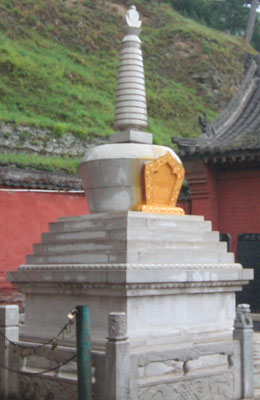Decorative Designs in Chinese Art 中国文物的纹饰
Carved Stone 石刻 Buddhist 佛教 Late Period 晚期
Click on any word to see more details.
Late Period 晚期
Feilai Peak 飞来峰 near Lingyin Temple 灵隐寺 in Hangzhou contains many wonderful cliff and cave sculptures, starting from around the Five Dynasties period (907—960). Lingyin Temple dates back to about 328 with construction in the present area in approximately 975. It is one of the oldest temples in Southern China and the largest in the Hangzhou area.
The relief sculpture below depicts Meeting with the Locana Buddha 卢舍那佛会, a scene from the Avatamsaka Sutra 华严经, also called Avatamsaka Three Saints 华严三圣. It is located at the mouth of the Qinglin Cave 青林洞 at Feilai Peak. Locana Buddha, also known as Vairocana Buddha 大日如来, is another body of Sakyamuni Buddha 释迦牟尼佛. Locana Buddha is in the center wearing a crown and sitting on a high lotus throne 莲座. The raised position of his arms and hand gestures indicate that he is speaking the Dharma. Manjusri Bodhisattva 文殊菩萨 is to Locana Buddha's left riding a lion. Samantabhadra Bodhisattva 普贤菩萨 is to Locana Buddha's right riding a white elephant with six tusks. Also, to the sides are four lokapala 天王 (or heavenly kings) and four bodhisattvas paying respect to Locana Buddha.
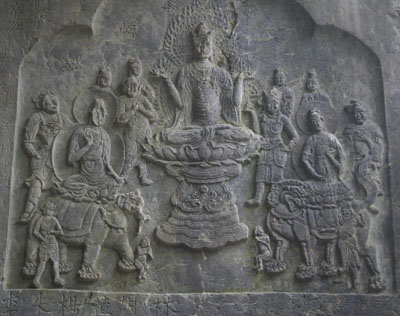
Chinese pagodas 塔 originate from India stupas. The word in Chinese is the same in both cases. In English we use the term stupa for the original Indian style, built in the shape of an upturned alms bowl and still common in Thailand, Burma, and other South and Southeast Asian countries. Chinese pagodas tend to be taller and more slender and come in a number of different styles. The one shown below is a stone pagoda 石塔 in Linyin Temple, Hangzhou. The detail on the right shows a false door 假门 carved on the outside of the pagoda. False windows and doors were common in early Indian stupas but have become less common in more recent Chinese pagodas. Their use relates to the practice of storing relics of monks and others within or under the pagodas.
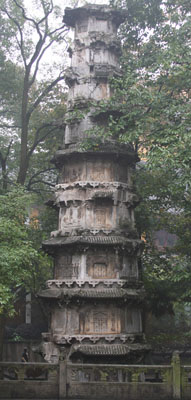
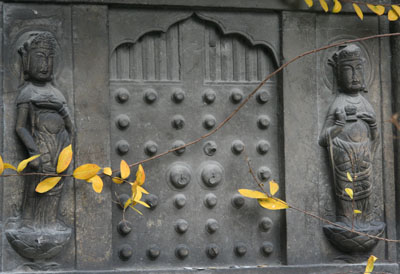
A sutra pillar 经幢 is a stone column placed outside of temples, most often present in temples dating in the Tang and before. Sutras or mantras are inscribed on them along with decorative carvings. The sutra pillar shown below is the West Sutra Pillar at Lingyin Temple. There are two sutra pillars in from of Lingyin Temple: one to the east and one to the west. The pillars are octagonal. The Usnisa Vijaya Dharani 尊胜陀罗尼经 is inscribed at the top of one pillar and the Great Freedom Dharani 大自在陀罗尼神咒经 on the other. In addition, there are relief sculptures of Buddhas and dragons on the pillars.
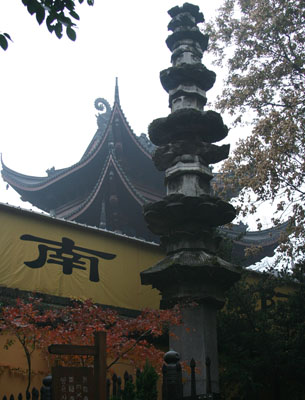
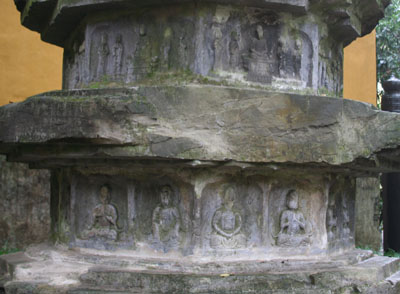
Maitreya Bodhisattva 弥勒菩萨 is one of the most commonly seen bodhisattvas in Chinese Buddhism. He will be the next Buddha of our world. Because he is a bodhisattva bringing great happiness and contentment he is often shown with a large belly in Chinese Buddhism and statues of Maitreya are often placed in food halls and Chinese restaurants. The picture below shows the Maitreya statue at Feilai Peak, which is one of the best preserved and most often photographed in the area. In one hand he is holding the cloth bag and in the other he is holding prayer beads 念珠. The cloth bag represents its contents: it is a lightweight bag that can hold things of any shape. Maitreya is flanked by 18 Arhats 罗汉 in this statue. It is the largest statue at Feilai Peak. The niche is 9.9 meters long and 3.6 meters high.
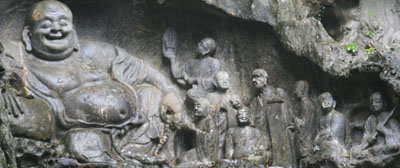
Manjusri Bodhisattva 文殊菩萨 is one of the four great Bodhisattvas of Chinese Buddhism. The others are Avalokitesvara Bodhisattva 观音菩萨, Ksitigarbha Bodhisattva 地藏菩萨, and Samantabhadra Bodhisattva 普贤菩萨. Since Manjusri is the Dharma Prince he is shown wearing a crown in the stone carving below.
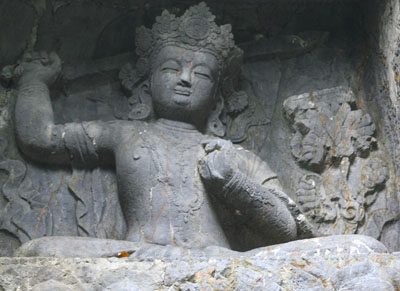
There are many Indian style sculptures at Feilai Peak. The picture below shows the Wealth Diety 宝藏神 carved in Indian style.
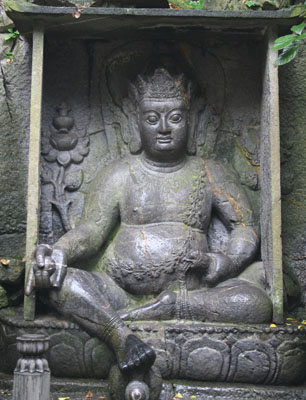
Vajrapani Bodhisattva 金刚手菩萨, literally Diamond Hand Bodhisattva, is one of the protectors of the Buddha. He is shown below in a picture of a cave stone carving at Feilai Peak. He is wearing a jewelled crown holding a small Buddha.
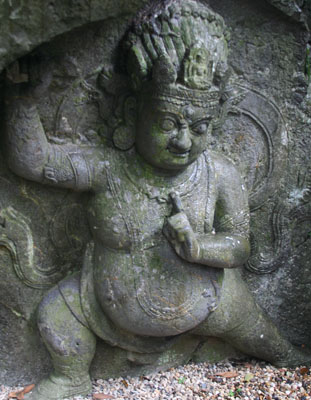
Duobao Pagoda 多宝塔 on Mount Putuo is 18 meters high with three levels and a square plan. Each side has a Buddha relief statue inside a niche. It was first built in 1335 during the Yuan but has been renovated since. The Medicine Buddha 药师佛 is usually shown in the east, as he is on Duobao Pagoda below. As per tradition, he is shown holding a jar of medicine nectar in his left hand.
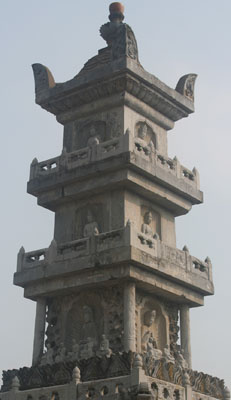
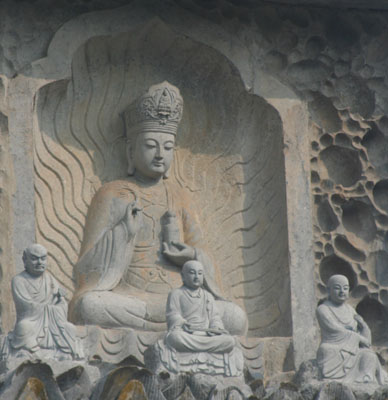
A nimbus 头光 is a light around the head while an aureole 身光 is a light around or behind the body. The Avalokitesvara Bodhisattva 观音菩萨 statue below has both a nimbus and an aureole.

Ksitigarbha 地藏菩萨 is the Bodhisattva of the Great Vow to not achieve Buddhahood until all the beings in Hell are saved. He carries a staff to open the gates of Hell and a jewel to light up darkness. It is called an alarm staff 警杖 because it can be carried by monks to warn off animals that might be trodden on by mistake.

Samantabhadra Bodhisattva 普贤菩萨, who symbolizes truth, is one of the four great bodhisattvas. As in the statue shown below, he is often shown riding an elephant with six tusks. The image is part of a long relief sculpture around the South China Sea Avalokitesvara Statue on Mount Putuo.
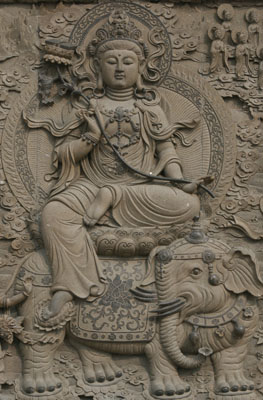
Putuo Shan 禅林普陀山, or Mount Putuo, began to be used as a center for Buddhism after Japanese monk Hui E 慧锷 tried to transport a Avalokitesvara Bodhisattva 观音菩萨 statue back to Japan from Mount Wutai in Shanxi but was shipwrecked on the island. In 916 Hui E built the temple Buken Qu Guanyin Temple 不肯去观音院. Since then many temples have been built on the island. Because of the story and Avalokitesvara Bodhisattva's important place in China as the bodhisattva of compassion the island has become a popular pilgrimage destination. The relief statue below tells the story in pictorial form.
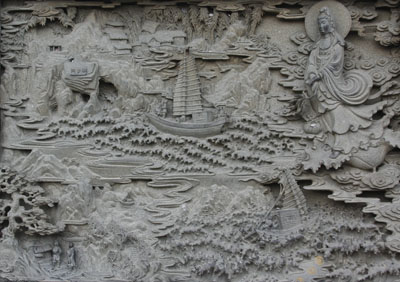
An Apsara 飞天 is a female spirit of clouds and water in Buddhist and Hindu mythology. The Apsaras shown below are from a carved relief sculpture on a wall at Lingyin Temple.
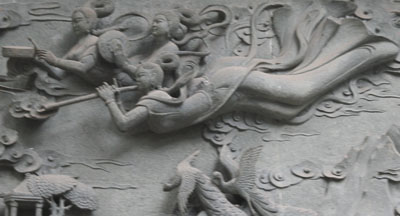
The pagoda shown below in Nan Putuoshan 南普陀山 temple in Xiamen is a small decorative model of a larger one. Decorative pagoda models like this are common. The unique Xiamen roof style is also shown in the background of this photo.
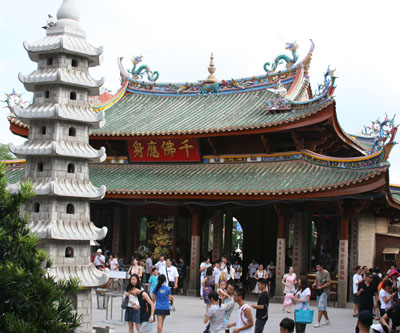
The photo below shows a Tibetan style stupa at Mount Wutai. This style is closer to the original Indian style stupa.
Chinese
Pinyin English
